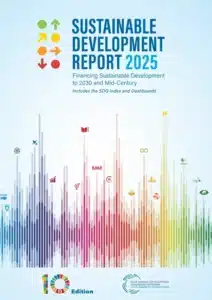Sustainable Development Report 2025
Financing Sustainable Development to 2030 and Mid-Century
Authors: Jeffrey Sachs, Guillaume Lafortune, Grayson Fuller, and Guilherme Iablonovski.

The Sustainable Development Report (SDR) reviews progress made each year on the Sustainable Development Goals since their adoption by the 193 UN Member States in 2015. Ahead of the 4th International Conference on Financing for Development (Ff4D) in Seville, Spain, the 10th edition of the SDR outlines urgent reforms to the Global Financial Architecture (GFA). This edition also includes for the first time an assessment of which countries have most progressed on the SDGs using a headline SDG Index (SDGi).
This year’s SDR emphasizes the following eight key messages:
- Global commitment to the SDGs is strong: 190 out of 193 countries have presented national action plans for advancing sustainable development. A decade after the adoption of Agenda 2030 and the SDGs, 190 of the 193 UN member states have participated in the Voluntary National Review (VNR) process, presenting their SDG implementation plans and sustainable development priorities to the international community. The European Union and State of Palestine have also presented VNRs. Most UN member states have presented two or more VNRs, and 39 countries volunteered to present one in 2025. Only three UN member states have not taken part in the VNR process: Haiti, Myanmar, and the United States. Additionally, a growing number of regional and local leaders have prepared Voluntary Local Reviews (VLRs) to report on SDG implementation at the subnational level. As of March 2025, 249 VLRs were listed on the dedicated UN website.
- East and South Asia has outperformed all other regions in SDG progress since 2015. This year’s SDR introduces a streamlined SDG Index (SDGi), which uses 17 headline indicators to track overall SDG progress. On average, East and South Asia has shown the fastest progress on the SDGs since 2015, driven notably by rapid progress on the socioeconomic targets.
- Other countries that have progressed more rapidly than their peers include the following: Benin (Sub-Saharan Africa), Nepal (East and South Asia), Peru (Latin America and the Caribbean), the United Arab Emirates (Middle East and North Africa), Uzbekistan (Eastern Europe and Central Asia), Costa Rica (OECD), and Saudi Arabia (G20).
- European countries continue to top the SDG Index. Finland ranks first this year and 19 of the top 20 countries are in Europe. Yet even these countries face significant challenges in achieving at least two goals, including those related to climate and biodiversity. In this year’s SDG Index, China (#49) and India (#99) have entered the top 50 and top 100 performers respectively.
- On average globally, the SDGs are far off-track. At the global level, none of the 17 goals are currently on course to be achieved by 2030. Conflicts, structural vulnerabilities, and limited fiscal space impede SDG progress in many parts of the world. But while only 17 percent of the targets are on track to be achieved worldwide, most UN member states have made strong progress on targets related to access to basic services and infrastructure, including mobile broadband use (SDG 9), access to electricity (SDG 7), internet use (SDG 9), under-5 mortality rate (SDG 3), and neonatal mortality (SDG 3).
- Barbados ranks first and the United States ranks last in UN-based multilateralism. Barbados stands out as the country most committed to UN-based multilateralism, while the United States ranks last in this year’s Index of countries’ support for UN-based multilateralism (UN-Mi). In early 2025, the United States announced its withdrawal from the Paris Climate Agreement and the World Health Organization (WHO) and formally declared its opposition to the SDGs and the 2030 Agenda. Among G20 countries, Brazil is the most committed to UN-based multilateralism, with Chile leading among OECD countries.
- For many developing countries, a lack of fiscal space is the major obstacle to SDG progress. Roughly half the world’s population lives in countries that cannot invest adequately in sustainable development due to debt burdens and a lack of access to affordable, long-term capital. Global public goods are vastly underfinanced. UN member states gathering at the 4th International Conference on Financing for Development (FfD4) in Seville, Spain (June 30 – July 3, 2025) have an enormous responsibility, not only to their own citizens but to all of humanity.
- Sustainable development offers high returns: capital should flow to the emerging and developing countries on more favourable terms. The Global Financial Architecture (GFA) is broken. Money flows readily to rich countries and not to the emerging and developing economies (EMDEs) that offer higher growth potential and rates of return. At the top of the agenda at FfD4 is the need to reform the GFA so that capital flows in far larger sums to the EMDEs. Part 1 of this report (also published online by the SDSN in May 2025) offers practical recommendations to scale up and align international financing flows to support global public goods and achieve sustainable development.
